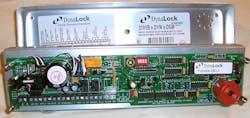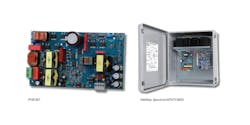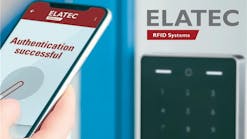DynaLock’s newest delayed egress product, the DynaLock 3101B, is classified as Special Locking Arrangements, making it ideal for many critical applications in security, such as access control, education, loss prevention, and patient care.
Security: The 3101B is an integral 1500lb electromagnetic lock, suitable for perimeter protection.
Access Control: The 3101B locks and unlocks with low voltage applied to its electromagnetic coil. Maglocks are a popular access control device.
Education: Schools must protect students and teachers without creating life safety problems by locking emergency exits. Delayed egress is one solution.
Loss Prevention: This is a booming market for applications such as retail stores which suffer dramatic shrinkage of inventory through unsupervised doors in the premises
Patient Care: Hospitals and managed care facilities use delayed egress to protect patients from wandering or escaping facilities.
DynaLock Corp. is a full line manufacturer of USA-made electronic security and access control products, headquartered in Bristol, CT. The DynaLock product line includes electromagnetic locks, electric strikes, electromechanical locks, magnetic door holders, power supplies, access/egress controls and consoles. The exclusive DynaLife® Lifetime Warranty is offered on all standard products.
The 3101B Series is designed to satisfy life safety codes as well as high security needs without compromising either. This next generation system offers improved technology, providing greater resistance to electrical surges.
The 3101B Delayed Egress Controller is the “electronics only” portion of the 3101B Maglock. The 3101B-ES is the controller in a standard 15”x12”x4” steel enclosure and the 3101B-R is in a 12”x12”x6” weatherproof enclosure with alarm horn.
The door must be equipped with a fail-safe lock that requires power to lock. The exit sequence is initiated by pushing on the exit device, or devices if it is a pair of doors.
At the end of the count, normally 15 seconds in total, the lock will release. The lock will remain unlocked (without power) until manually re-locked by a reset device. Life safety codes differ on how the reset is performed.
In a typical installation, the door is normally closed and latched by the existing mechanical door hardware and magnetically secured by the 3101B Lock. Attempting to exit by applying 15 pounds or less pressure to the door for a time period longer than the “Nuisance Delay” will cause the door to become unlatched, trigger the 3101B integral sensor, and activate the 3101B delay egress timer. The alarm and red LED will pulsate for 15 seconds (30 seconds field selectable), and after the time delay has elapsed, the lock will release and the alarm will sound continuously with a green LED until the door is shut and the lock is reset.
Note: Nuisance Delay is a time period programmed into the initiating circuit that ignores short pressure on the exit bar (or door if it is part of the initiating device). Such events may be caused by accidentally bumping the door, or gusts of wind, etc. The intent of a nuisance alarm is to minimize false alarms and maintain security on the door.
Alarm reset and lock bypass are accomplished with the 3101B’s built in keyswitch or by means of an external remote switch or control supplied by the installer.
The system unlocks immediately when the 3101B is properly connected to the building emergency fire alarm system, or power is removed from the maglock. Fire alarm contacts on the 3101B Lock are field selectable for NO and NC signals.
Premises in which delayed egress systems are installed must have fire alarm systems, and the delayed egress system must be connected so that if the fire alarm is activated, the door unlocks and permits uninhibited egress.
Always check with your local authority having jurisdiction to determine the exact requirements for each project and application.. Five building codes in the United States and Canada have subtle differences. These are: NFPA 101 Special Locking Arrangements; SBC Standard Building Code; UBC Uniform Building Code; BOCA Building Officials Code Administrators; and NBC National Building Code Of Canada.
STANDARD FEATURES
Microprocessor Controlled: An advanced digital processor on-board manages all lock functions, without the need for an external system controller. Custom factory programs are available to meet varying job requirements and building codes.
Easy Installation: The micrometer style adjustment wheel simplifies calibration of delay egress sensor and works with existing door hardware. The 3101B does not require touch or electrified exit devices, electric hinges, door cords or an additional power supply.
Reliability: The integral Watchdog Circuit will signal malfunction with pulsating LED and alarm for maximum dependability.
Selectable Nuisance Delay: The 3101B has a 1 or 3 second nuisance alarm to deter false alarms.
Consistent performance: The DynaLock 3101B uses a concealed optical sensor which resists tampering and is unaffected by wind, or door/frame warpage or sag. This sensor is easily adjusted by the installer. For applications where latching hardware is not used, this sensor can be bypassed, and an external bar (such as the DynaLock #6451 Exit Sensor Bar) can be used to trigger the delayed egress.
Holding Force: The 3101B has a Holding Force 1500 Lbs. which puts it into the premier high security category. The 3101B will effectively resist forced opening of the subject door from inside or outside the protected area.
MOUNTING
A template is provided with the unit to facilitate marking of mounting and wiring holes. The lock incorporates an armature mounting plate to which the armature is attached. This makes the mounting of the armature easier for retrofits, since the plate may be mounted over previous door prep or may be easier to install on narrow frames or metal doors with a top channel than a typical armature bolt might interfere with. Since installation does not require drilling completely through the door for the armature mounting bolt.
DynaLock’s “Fas-Trak” mounting also makes it easier for a single locksmith to install a 3101B, since several steps involving drilling and aligning the heavy magnet housing are essentially eliminated. The FAS Trak also keeps the electronics off the door and out of harms way while drilling and wire pulling is being performed.
Major system settings are via jumpers and DIP switch in the 3101B housing. Wiring connections are made to a terminal strip inside the 3101B housing. It’s all pretty straightforward and clearly explained and illustrated in the installation instructions.
The 3101B is a versatile. With its on-board key switch, it can be deployed with just a power supply and FAC connection. It can also be used in a wide variety of delayed egress applications to accomplish just about any requirement.
DynaLock has all the installation brackets and accessories you want, and expert telephone tech support Monday-Friday till 8 p.m. Eastern. For information, contact your local locksmith distributor or DynaLock Corp., Web Site: www.DynaLock.com





